Characteristics of Vein-Forming Fluids in the Sinian Dengying Formation Reservoir and Its Relationship with the Hydrocarbon Accumulation Process in the Southwest and Southeast of the Sichuan Basin
Abstract
:1. Introduction
2. Geological Background
3. Samples and Methods
4. Results
4.1. Petrographic Characteristics
4.2. Rare Earth Elements (REEs)
4.3. Carbon, Oxygen, and Strontium Isotopes
4.4. Characteristics of Fluid Inclusions
4.5. BasinMod Simulates the Stage of Hydrocarbon Accumulation Evolution
5. Discussion
5.1. Rare Earth Elements Indicate the Characteristics of Dolomite Vein Fluids
5.2. Carbon, Oxygen, and Strontium Isotopes Indicate the Characteristics of Dolomite Vein Fluids
5.3. Formation Time of Dolomite Veins and Minerals
5.4. Multistage Fluid and Process of Hydrocarbon Accumulation
6. Conclusions
- (1)
- The results of vein petrography, cathodoluminescence, and in situ microanalysis of elements from the studied samples show that two stages of dolomite and one stage of quartz are developed in the 4th member of the Dengying Formation in the southeast of the Sichuan Basin, and three stages of dolomite are developed in the 2nd member of the Dengying Formation in the southwest of the Sichuan Basin.
- (2)
- Rare earth elements and carbon, oxygen, and strontium isotopes with the studied samples indicate that the source of dolomite vein-forming fluids in the two development stages of the 4th member of the Dengying Formation in the southeast of the Sichuan Basin were marine reservoir diagenetic fluids. The dolomite II REE distribution curves show obvious positive Eu anomaly on the whole, indicating that it was affected by a certain degree of hydrothermal activity, which may have been caused by the deep hydrothermal activity of the Emei mantle plume. The dolomite vein-forming fluids of the three development stages of the 2nd member of the Dengying Formation in the southwest of the Sichuan Basin were the sources of marine reservoir diagenetic fluid. The REE distribution curves of dolomite II and dolomite III show a certain degree of Eu positive anomaly, indicating that they were all affected by hydrothermal activity. The influence of hydrothermal activity on dolomite came from the deep hydrothermal activity caused by the Emei mantle plume activity.
- (3)
- The carbon and oxygen isotope values of the dolomite vein samples of the 4th member of the Dengying Formation in the southeast of the Sichuan Basin are smaller than those of the 2nd member of the Dengying Formation in the southwest of the Sichuan Basin, showing a negative deviation. The vein forming fluid of the 4th member of the Dengying Formation in the southeast of the Sichuan Basin is affected by strontium-rich fluid (crust source strontium), while the 2nd member of the Dengying Formation in the southwest of the Sichuan Basin may not be affected by obvious strontium-rich fluid.
- (4)
- The formation time of dolomite I in the 4th member of the Dengying Formation in the southeast of the Sichuan Basin was about 421 Ma, the formation time of dolomite II was about 288 Ma, the formation time of quartz was about 432 Ma, and the capture time of secondary methane inclusions in quartz was about 20 Ma. The formation times of dolomite I, dolomite II, and dolomite III in the 2nd member of the Dengying Formation in the southwest of the Sichuan Basin were about 425 Ma, 283 Ma, and 262 Ma, respectively, and the capture time of methane-bearing brine inclusions in the dolomite III was about 19 Ma.
- (5)
- The fluid activity and hydrocarbon accumulation evolution sequence in the southeast and southwest of the Sichuan Basin are determined comprehensively. The sequence of the 4th member of the Dengying Formation in the southeast of the Sichuan Basin is as follows: quartz (~432 Ma) → dolomite I (~421 Ma) → oil filling I (460–400 Ma) → dolomite II (~288 Ma) → oil filling II (300–270 Ma) → gas escaping (~75 Ma). The sequence of the 2nd member of the Dengying Formation in the southwest of the Sichuan Basin is as follows: dolomite I (~425 Ma) → oil filling I (430–400 Ma) → dolomite II (~283 Ma) → oil filling II (290–230 Ma) → dolomite III (~262 Ma) → gas escaping (~85 Ma).
Author Contributions
Funding
Data Availability Statement
Acknowledgments
Conflicts of Interest
References
- He, Z.L.; Jin, X.H.; Wo, Y.J.; Li, H.L.; Bai, Z.R.; Jiao, C.L.; Zhang, Z.P. Hydrocarbon accumulation characteristics and exploration domains of ultra-deep marine carbonates in China. China Pet. Explor. 2016, 21, 3–14, (In Chinese with English Abstract). [Google Scholar]
- Ma, Y.S.; Cai, X.Y.; Zhao, P.R. The research status and advances in porosity evolution and diagenesis of deep carbonate reservoir. Earth Sci. Front. 2011, 18, 181–192. [Google Scholar]
- Heydari, E. Porosity loss, fluid flow, and mass transfer in limestone reservoirs: Application to the Upper Jurassic Smackover Formation, Mississippi. AAPG Bull. 2000, 84, 100–118. [Google Scholar]
- Jin, Z.J. Formation and accumulation of oil and gas in marine carbonate strata in Chinese sedimentary basins. Sci. China Earth Sci. 2011, 41, 910–926. [Google Scholar]
- Zhu, G.Y.; Zhang, S.C. Hydrocarbon accumulation conditions and exploration potential of deep reservoirs in China. Acta Pet. Sin. 2009, 30, 793–802. [Google Scholar]
- Zou, C.N.; Du, J.H.; Xu, C.C.; Wang, Z.C.; Zhang, B.M.; Wei, G.Q.; Wang, T.S.; Yao, G.S.; Deng, S.H.; Liu, J.J.; et al. Formation, distribution, resource potential and discovery of the Sinian-Cambrian giant gas field, Sichuan Basin, SW China. Pet. Explor. Dev. 2014, 41, 278–293. [Google Scholar] [CrossRef]
- Du, J.H.; Zou, C.N.; Xu, C.C.; He, H.Q.; Shen, P.; Yang, Y.M.; Li, Y.L.; Wei, G.Q.; Wang, Z.C.; Yang, Y. Theoretical and technical innovations in strategic discovery of a giant gas field in Cambrian Longwangmiao Formation of central Sichuan paleo-uplift, Sichuan Basin. Pet. Explor. Dev. 2014, 41, 294–305. [Google Scholar] [CrossRef]
- Wei, G.Q.; Du, J.H.; Xu, C.C.; Zou, C.N.; Yang, W.; Shen, P.; Xie, Z.Y.; Zhang, J. Characteristics and accumulation modes of large gas reservoirs in Sinian-Cambrian of Gaoshiti-Moxi region, Sichuan Basin. Acta Pet. Sin. 2015, 36, 1–12. [Google Scholar] [CrossRef]
- Wang, Z.C.; Wang, T.S.; Wen, L.; Jiang, H.; Zhang, B.M. Basic geological characteristics and accumulation conditions of Anyue giant gas field, Sichuan Basin. China Offshore Oil Gas 2016, 28, 45–52, (In Chinese with English Abstract). [Google Scholar]
- Fan, T.Y.; Jiang, L.; Nie, Q.; Zhao, W.T.; Wu, Y.; Geng, C.; Zou, X.; Li, T. Evaluation on development potential in the Lower Cambrian Longwangmiao Formation, Gaoshiti block, Anyue gasfield, Sichuan Basin. Nat. Gas Explor. Dev. 2021, 44, 44–55, (In Chinese with English Abstract). [Google Scholar]
- Li, S.; Zhou, Y.; Xiao, K.; Wo, Y. Characteristics of Silurian destroyed oil reservoir in Houtan section of Xishui area in southeastern margin of Sichuan Basin. Acta Pet. Sin. 2009, 30, 849–855. [Google Scholar]
- Sun, W.; Liu, S.G.; Wang, G.Z.; Xu, G.S.; Yong, Z.Q.; Huang, W.M. Petroleum formed condition and process research for Sinian to Low Paleozoic at Dingshan structure in southeast of Sichuan Basin. Geol. Sci. Technol. Inf. 2010, 29, 49–55, (In Chinese with English Abstract). [Google Scholar]
- Wei, G.Q.; Shen, P.; Yang, W.; Zhang, J.; Jiao, G.H.; Xie, W.R.; Xie, Z.Y. Formation conditions and exploration prospects of Sinian large gas fields, Sichuan Basin. Pet. Explor. Dev. 2013, 40, 129–138. [Google Scholar] [CrossRef]
- Chang, Y.Q.; Sun, W.; Li, Z.Q.; Ye, Y.H.; Jiao, K.; Yuan, Y.; Tian, M.N. Oil and gas exploration prospects of the deep buried Dengying Formation in the southeastern Sichuan Basin, China. J. Chengdu Univ. Technol. Sci. Technol. Ed. 2019, 46, 142–152, (In Chinese with English Abstract). [Google Scholar]
- Liu, S.G.; Ma, Y.S.; Huang, W.M.; Cai, X.Y.; Zhang, C.J.; Wang, G.Z.; Xu, G.S.; Yong, Z.Q.; Pan, C.L. Densification process of upper Sinian Dengying Formation, Sichuan Basin. Nat. Gas Geosci. 2007, 18, 485–496. [Google Scholar]
- Zhou, Z.; Wang, X.Z.; Xie, L.; Mo, J.; Zhang, J. Reservoir features and physical influences of the Sinian Dengying Formation (Sinian) in central Sichuan, China. Nat. Gas Geosci. 2014, 25, 701–708. [Google Scholar]
- Shi, Z.J.; Peng, J.; Wang, Y. Reservoir features and controlling factors of Dengying Formation in southeast Sichuan, China. J. Chengdu Univ. Technol. Sci. Technol. Ed. 2010, 37, 1–8, (In Chinese with English Abstract). [Google Scholar]
- Zhu, D.Y.; Zhang, D.W.; Liu, Q.Y.; He, Z.L.; Li, S.J.; Zhang, R.Q. Dynamic development process and mechanism of dolomite reservoir under multi-fluid alterations. Nat. Gas Geosci. 2015, 26, 2053–2062. [Google Scholar]
- Yang, P.; Xie, Y.; Wang, Z.J.; Li, Q.Y.; Liu, J.H.; Zhang, D.; Yang, Z.; Yin, F. Fluid activity and hydrocarbon accumulation period of Sinian Dengying Formation in Northern Guizhou, South China. Pet. Explor. Dev. 2014, 41, 313–335. [Google Scholar] [CrossRef]
- Wei, G.Q.; Yang, W.; Du, J.H.; Xu, C.C.; Zou, C.N.; Xie, W.R.; Wu, S.J.; Zeng, F.Y. Tectonic features of Gaoshiti-Moxi paleo-uplift and its controls on the formation of a giant gas field, Sichuan Basin, SW China. Pet. Explor. Dev. 2015, 42, 257–265. [Google Scholar] [CrossRef]
- Ma, W.X.; Liu, S.G.; Huang, W.M.; Zhang, C.J.; Xu, G.S.; Yuan, H.F. Characteristics of Silurian Paleo-oil reservoirs and their significance for petroleum exploration on the southeast margin of Sichuan Basin. Oil Gas Geol. 2012, 33, 432–441. [Google Scholar]
- Wang, G.Z.; Liu, S.G.; Liu, W.; Fan, L.; Yuan, H.F. Process of hydrocarbon accumulation of Sinian Dengying Formation in Gaoshiti structure, Central Sichuan, China. J. Chengdu Univ. Technol. Sci. Technol. Ed. 2014, 41, 684–693, (In Chinese with English Abstract). [Google Scholar]
- Huang, W.M.; Liu, S.G.; Xu, G.S.; Wang, G.Z.; Ma, W.X.; Zhang, C.J.; Song, G.Y. Characteristics of paleo oil pools from Sinian to Lower Paleozoic in southeastern margin of Sichuan Basin. Geol. Rev. 2011, 57, 285–299, (In Chinese with English Abstract). [Google Scholar]
- Liu, S.G.; Qin, C.; Sun, W.; Wang, G.Z.; Xu, G.S.; Yuan, H.F.; Zhang, C.J.; Zhang, C.J. The coupling formation process of four centers of hydrocarbon in Sinian Dengying Formation of Sichuan Basin. Acta Petrol. Sin. 2012, 28, 879–888. [Google Scholar]
- Jiang, H.; Wang, Z.C.; Du, H.Y.; Zhang, C.M.; Wang, R.J.; Zou, N.N.; Wang, T.S.; Gu, Z.D.; Li, Y.X. Tectonic evolution of the Leshan-Longnvsi paleo-uplift and reservoir formation of Neoproterozoic Sinian gas. Nat. Gas Geosci. 2014, 25, 192–200. [Google Scholar]
- Sun, W.; Liu, S.G.; Song, J.M.; Deng, B.; Wang, G.Z.; Wu, J.; Jiao, K.; Li, J.X.; Ye, Y.H.; Li, Z.W.; et al. The formation process and characteristics of ancient and deep carbonate petroleum reservoirs in superimposed basins: A case study of Sinian (Ediacaran) Dengying Formation in the Sichuan superimposed basin, China. J. Chengdu Univ. Technol. Sci. Technol. Ed. 2017, 44, 257–285, (In Chinese with English Abstract). [Google Scholar]
- Wang, G.Z.; Liu, S.G. Paleo-fluid geochemical evaluation of hydrocarbon preservation in marine carbonate rock areas: Taking lower association in central Sichuan Basin as an example. J. Chengdu Univ. Technol. Sci. Technol. Ed. 2009, 36, 631–644, (In Chinese with English Abstract). [Google Scholar]
- Shi, Z.J.; Wang, Y.; Tian, Y.M.; Wang, C.C. Cementation and diagenetic fluid of algal dolomites in the Sinian Dengying Formation in southeastern Sichuan Basin. Sci. China Earth Sci. 2013, 56, 192–202. [Google Scholar] [CrossRef]
- Feng, M.Y.; Qiang, Z.T.; Shen, P.; Zhang, J.; Tao, Y.Z.; Xia, M.L. Evidences for hydrothermal dolomite of Sinian Dengying Formation in Gaoshiti-Moxi area, Sichuan Basin. Acta Pet. Sin. 2016, 37, 587–598. [Google Scholar]
- Luo, B.; Yang, Y.M.; Luo, W.J.; Wen, L.; Wang, W.Z.; Chen, K. Controlling factors and distribution of reservoir development in Dengying Formation of paleo-uplift in central Sichuan Basin. Acta Pet. Sin. 2015, 36, 416–426. [Google Scholar]
- Eichhubl, P.; Boles, J.R. Focused fluid flow along faults in the Monterey Formation, coastal California. Geol. Soc. Am. Bull. 2000, 112, 1667–1679. [Google Scholar] [CrossRef]
- Ye, J.R.; Yang, X.H. Thermal fluid flow in sedimentary basins and its significance to pool-forming dynamics. Acta Sedimentol. Sin. 2001, 19, 214–218, (In Chinese with English Abstract). [Google Scholar]
- Williams, R.T.; Goodwin, L.B.; Mozley, P.S.; Beard, B.L.; Johnson, C.M. Tectonic controls on fault zone flow pathways in the Rio Grande rift, New Mexico, USA. Geology 2015, 43, 723–726. [Google Scholar] [CrossRef] [Green Version]
- Gui, L.L.; Zhao, M.J.; Liu, K.Y.; Luo, M.; Meng, Q.Y.; Yuan, L.; Hao, J.Q. Reservoir fluid evolution and hydrocarbon charge history of the Gasi E13 Oilfield, southwestern Qaidam Basin. Nat. Gas Geosci. 2016, 27, 289–297. [Google Scholar]
- Luo, T.; Guo, X.W.; Shu, Z.G.; Bao, H.Y.; He, S.; Qin, Z.J.; Xiao, Z.H. Fluid source and formation time of fracture veins of Wufeng Formation and Longmaxi Formation in the south of Jiaoshiba area, Sichuan Basin. Acta Pet. Sin. 2021, 42, 611–622. [Google Scholar]
- Wei, G.Q.; Yang, W.; Xie, W.R.; Xie, Z.Y.; Zeng, F.Y.; Mo, W.L.; Shen, J.H.; Jin, H. Formation conditions, accumulation models and exploration direction of large gas fields in Sinian-Cambrine, Sichuan Basin. Nat. Gas Geosci. 2015, 26, 785–795. [Google Scholar]
- Liu, S.G.; Sun, W.; Li, Z.W.; Deng, B.; Zhong, Y.; Song, J.M.; Ran, B.; Luo, Z.L.; Han, K.Y.; Jiang, L.; et al. Distribution characteristics of marine carbonate reservoirs and their tectonic controlling factors across the Sichuan superimposed basin. Litholgic Reserv. 2016, 28, 1–17, (In Chinese with English Abstract). [Google Scholar]
- Sun, Z.M.; Zhang, R.Q.; Sun, W.; Hao, Y.Q.; Bian, C.R. Petroleum exploration domains and favorable directions of the lower marine assemblage in Eastern Sichuan Basin. Geoscience 2021, 35, 798–806, (In Chinese with English Abstract). [Google Scholar]
- Qin, Z.P.; Liu, S.G.; Deng, B.; Li, Z.W.; Sun, W. Multiphase structural features and evolution of Southeast Sichuan tectonic belt in China. J. Chengdu Univ. Technol. Sci. Technol. Ed. 2013, 40, 703–711, (In Chinese with English Abstract). [Google Scholar]
- Zhang, G.C. Analysis on carbonate hydrocarbon exploration potential from Sinian to Silurian in southeast of Sichuan. S. China Oil Gas 2003, 16, 15–18, (In Chinese with English Abstract). [Google Scholar]
- Liu, R.B.; Tian, J.C.; Wei, Z.H.; Zhang, M.W.; Zhong, S.Q.; Zhang, G.H.; Wang, B. Comprehensive research of effective hydrocarbon source rock of lower strata from Sinian to Silurian system in southeast area of Sichuan Province. Nat. Gas Geosci. 2006, 17, 824–827. [Google Scholar]
- Zhang, G.Y.; Zhao, W.Z.; Zou, C.N.; Li, W.; Fang, X. Petroleum geological conditions and exploration potential in middle and lower combinations of onshore superimposed basins in China. Earth Sci. Front. 2008, 15, 120–126. [Google Scholar]
- Wang, X.Z.; Mu, S.G.; Fang, S.X.; Huang, J.X.; Hou, F.H. Evolution of porosity in the process of Sinian dolostone diagenesis in Southwest Sichuan. Acta Sedimentol. Sin. 2000, 18, 549–554, (In Chinese with English Abstract). [Google Scholar]
- Shi, Z.J.; Liang, P.; Wang, Y.; Hu, X.Q.; Tian, Y.M.; Wang, C.C. Geochemical characteristics and genesis of grapestone in Sinian Dengying Formation in south-eastern Sichuan Basin. Acta Petrol. Sin. 2011, 27, 2263–2271. [Google Scholar]
- Huang, H.; Chen, X.D.; Hu, H.W. The division and analysis of the favorable reservoir depositional facies of the Dengying Formation Upper-Sinian in southeastern Sichuan Basin. Petrochem. Ind. Appl. 2012, 31, 49–53, (In Chinese with English Abstract). [Google Scholar]
- Zhou, J.G.; Zhang, J.Y.; Deng, H.Y. Lithofacies paleogeography and sedimentary model of Sinian Dengying Fm in the Sichuan Basin. Nat. Gas Ind. 2017, 37, 24–31. [Google Scholar] [CrossRef]
- Duan, J.B.; Mei, Q.H.; Li, B.S.; Liang, Z.R. Sinian-early Cambrian tectonic-sedimentary evolution in Sichuan Basin. Earth Sci. 2019, 44, 738–755. [Google Scholar]
- Coryell, C.D.; Chase, J.W.; Winchester, J.W. A procedure for geochemical interpretation of terrestrial rare-earth abundance patterns. J. Geophys. Res. 1963, 68, 559–566. [Google Scholar] [CrossRef]
- Piper, D.Z. Rare earth elements in the sedimentary cycle: A summary. Chem. Geol. 1974, 14, 285–304. [Google Scholar] [CrossRef]
- Hecht, L.; Freiberger, R.; Gilg, H.A.; Grundmann, G.; Kostitsyn, Y.A. Rare earth element and isotope (C, O, Sr) characteristics of hydrothermal carbonates: Genetic implications for dolomite-hosted talc mineralization at Gopfersgrun (Fichtelgebirge, Germany). Chem. Geol. 1999, 155, 115–130. [Google Scholar] [CrossRef]
- Zhao, Y.Y.; Li, S.Z.; Li, D.; Guo, L.L.; Dai, L.M.; Tao, J.L. Rare earth element geochemistry of carbonate and its paleoenvironmental implications. Geotecton. Metallog. 2019, 43, 141–167, (In Chinese with English Abstract). [Google Scholar]
- Wu, Z.R.; He, S.; He, X.P.; Zhai, G.Y.; Huang, Y.H.; Zhao, W.; Han, Y.J.; Yang, R. Characteristics of fluid inclusions in fracture calcite veins and implications of upper Permain Dalong Formation shale at the Lianyuan Depression. Geol. Sci. Technol. Inf. 2019, 38, 70–81. [Google Scholar]
- Liu, L.; He, S.; Zhai, G.Y.; Chen, K.; Liu, Z.X.; Wang, Y.; Han, Y.J.; Dong, T. Diagenetic environment evolution of fracture veins of shale core in second member of Niutitang Formation in southern limb of Huangling Anticline and its connection with shale gas preservation. Earth Sci. 2019, 44, 3583–3597. [Google Scholar]
- Kawakami, Y.; Yamamoto, J.; Kagi, H. Micro-raman densimeter for CO2 inclusions in mantle-derived minerals. Appl. Spectrosc. 2003, 57, 1333–1339. [Google Scholar] [CrossRef]
- Dubessy, J.; Buschaert, S.; Lamb, W.; Pironon, J.; Thiéry, R. Methane-bearing aqueous fluid inclusions: Raman analysis, thermodynamic modelling and application to petroleum basins. Chem. Geol. 2001, 173, 193–205. [Google Scholar] [CrossRef]
- Haskin, L.A.; Haskin, M.A.; Frey, F.A.; Wideman, T.R. Relative and absolute terrestrial abundances of the rare earths. Orig. Distrib. Elem. 1968, 889–912. [Google Scholar]
- Nothdurft, L.D.; Webb, G.E.; Kamber, B.S. Rare earth element geochemistry of Late Devonian reefal carbonates, Canning Basin, Western Australia: Confirmation of a seawater REE proxy in ancient limestones. Geochim. Cosmochim. Acta 2004, 68, 263–283. [Google Scholar] [CrossRef]
- Alexander, B.W.; Bau, M.; Andersson, P.; Dulski, P. Continentally-derived solutes in shallow Archean seawater: Rare earth element and Nd isotope evidence in iron formation from the 2.9 Ga Pongola Supergroup, South Africa. Geochim. Cosmochim. Acta 2008, 72, 378–394. [Google Scholar] [CrossRef]
- Tostvein, R.; Shields, G.A.; Tarbuck, G.M.; He, T.; Clarkson, M.O.; Wood, R.A. Effective use of cerium anomalies as a redox proxy in carbonate-dominated marine settings. Chem. Geol. 2016, 438, 146–162. [Google Scholar] [CrossRef] [Green Version]
- Zhao, Y.; Wei, W.; Li, S.; Yang, T.; Zhang, R.; Somerville, I.; Santosh, M.; Wei, H.; Wu, H.; Yang, J.; et al. Rare earth element geochemistry of carbonates as a proxy for deep-time environmental reconstruction. Palaeogeogr. Palaeoclimatol. Palaeoecol. 2021, 574, 110443. [Google Scholar] [CrossRef]
- Bau, M.; Dulski, P. Comparing yttrium and rare earths in hydrothermal fluids from the Mid-Atlantic Ridge: Implications for Y and REE behaviour during near-vent mixing and for the Y/Ho ratio of Proterozoic seawater. Chem. Geol. 1999, 155, 77–90. [Google Scholar] [CrossRef]
- Mitra, A.; Elderfield, H.; Greaves, M.J. Rare earth elements in submarine hydrothermal fluids and plumes from the Mid-Atlantic Ridge. Mar. Chem. 1994, 46, 217–235. [Google Scholar] [CrossRef]
- James, R.H.; Elderfield, H. Chemistry of ore-forming fluids and mineral formation rates in an active hydrothermal sulfide deposit on the Mid-Atlantic Ridge. Geology 1996, 24, 1147–1150. [Google Scholar] [CrossRef]
- Bau, M.; Balan, S.; Schmidt, K.; Koschinsky, A. Rare earth elements in mussel shells of the Mytilidae family as tracers for hidden and fossil high-temperature hydrothermal systems. Earth Planet. Sci. Lett. 2010, 299, 310–316. [Google Scholar] [CrossRef]
- Song, X.Y.; Hou, Z.Q.; Wang, Y.L.; Zhang, C.J.; Cao, Z.M.; Li, Y.G. The mantle plume features of Emeishan basalts. Mineral. Petrol. 2002, 22, 27–32, (In Chinese with English Abstract). [Google Scholar]
- Zhu, C.Q.; Xu, M.; Yuan, Y.S.; Zhao, Y.Q.; Shan, J.N.; He, Z.G.; Tian, Y.T.; Hu, S.B. Palaeo-geothermal response and record of the effusing of Emeishan basalts in Sichuan basin. Chin. Sci. Bull. 2010, 55, 474–482. [Google Scholar] [CrossRef]
- Wang, R.H.; Tan, Q.Y.; Fu, J.Y.; Mou, C.L.; Cheng, J.X.; Wang, Z.H. The sedimentary-tectonic evolution and sedimentary response of mantle plume in Emeishan. Earth Sci. Front. 2011, 18, 201–210. [Google Scholar]
- Taylor, K.G.; Gawthorpe, R.L.; Curtis, C.D.; Marshall, J.D.; Awwiller, D.N. Carbonate cementation in a sequence-stratigraphic framework: Upper Cretaceous sandstones, Book Cliffs, Utah-Colorado. J. Sediment. Res. 2000, 70, 360–372. [Google Scholar] [CrossRef]
- Huang, S.J.; Qing, H.R.; Pei, C.R.; Hu, Z.W.; Wu, S.J.; Sun, Z.L. Strontium concentration, isotpe composition and dolomitization fluids in the Feixianguan Formation of Triassic, Eastern Sichuan of China. Acta Petrol. Sin. 2006, 22, 2123–2132. [Google Scholar]
- Yang, X.Y.; He, S.; He, Z.L.; Wang, F.R.; Li, T.Y. Characteristics and pale-fluid activity implications of fluid-inclusion and isotope of calcite veins in Jingshan area. J. China Univ. Pet. 2013, 37, 19–34. [Google Scholar]
- Fayek, M.; Harrison, T.M.; Grove, M.; Mckeegan, K.D.; Coath, C.D.; Boles, J.R. In situ stable isotopic evidence for protracted and complex carbonate cementation in a petroleum reservoir, North Coles Levee, San Joaquin Basin, California, USA. J. Sediment. Res. 2001, 71, 444–458. [Google Scholar] [CrossRef]
- Mcarthur, J.M.; Kennedy, W.J.; Chen, M. Strontium isotope stratigraphy for Late Cretaceous time: Direct numerical calibration of the Sr isotope curve based on the US Western Interior. Palaeogeogr. Palaeoclimatol. Palaeoecol. 1994, 108, 95–119. [Google Scholar] [CrossRef]
- Wang, Z.C.; Jiang, H.; Wang, T.S.; Lu, W.H.; Gu, Z.D.; Xu, A.N.; Yang, Y.; Xu, Z.H. Paleo-geomorphology formed during Tongwan tectonization in Sichuan Basin and its significance for hydrocarbon accumulation. Pet. Explor. Dev. 2014, 41, 305–312. [Google Scholar] [CrossRef]
- Li, W.; Liu, J.J.; Deng, S.H.; Zhang, B.M.; Zhou, H. The nature and role of Late Sinian-Early Cambrian tectonic movement in Sichuan Basin and its adjacent areas. Acta Pet. Sin. 2015, 36, 546–556. [Google Scholar]
- Palmer, M.R.; Edmond, J.M. The strontium isotope budget of the modern ocean. Earth Planet. Sci. Lett. 1989, 92, 11–26. [Google Scholar] [CrossRef]
- Zhao, J.Z.; Li, X.R. Methods of geochronology of petroleum accumulation. Xinjiang Pet. Geol. 2002, 23, 257–261, (In Chinese with English Abstract). [Google Scholar]
- Chen, H.H. Advances in geochronology of hydrocarbon accumulation. Oil Gas Geol. 2007, 28, 143–150. [Google Scholar]
- Bourdet, J.; Pironon, J.; Levresse, G.; Tritlla, J. Petroleum type determination through homogenization temperature and vapour volume fraction measurements in fluid inclusions. Geofluids 2008, 8, 46–59. [Google Scholar] [CrossRef]
- Larson, L.T.; Miller, J.D.; Nadeau, J.E. Two sources of error in low temperature inclusion homogenization determination, and corrections on published temperatures for the East Tennessee and Laisvall deposits. Econ. Geol. 1973, 68, 113–116. [Google Scholar] [CrossRef]
- Guo, X.W.; Chen, J.X.; Yuan, S.Q.; He, S.; Zhao, J.X. Constraint of in-situ calcite U-Pb dating by laser ablation on geochronology of hydrocarbon accumulation in petroliferous basins: A case study of Dongying sag in the Bohai Bay Basin. Acta Pet. Sin. 2020, 41, 284–291. [Google Scholar]
- Qiu, N.; Liu, Y.F.; Liu, W.; Jia, J.K. Quantitative reconstruction of formation paleo-pressure in sedimentary basins and case studies. Sci. China Earth Sci. 2020, 63, 808–821. [Google Scholar] [CrossRef]
- Liu, S. Formation time and formation mechanism of the Weiyuan antlcline in Sichuan Basin. J. Chengdu Univ. Technol. 2001, 28, 340–343, (In Chinese with English Abstract). [Google Scholar]
- Xu, H.L.; Wei, G.Q.; Jia, C.Z.; Yang, W.; Zhou, T.W.; Xie, W.R.; Li, C.X.; Luo, B.W. Tectonic evolution of the Leshan-Longnvsi paleo-uplift and its control on gas accumulation in the Sinian strata, Sichuan Basin. Pet. Explor. Dev. 2012, 39, 406–416. [Google Scholar] [CrossRef]
- Mei, Q.H.; He, D.F.; Wen, Z.; Li, Y.Q.; Li, J. Geologic structure and tectonic evolution of Leshan-Longnvsi paleo-uplift in Sichuan Basin, China. Acta Pet. Sin. 2014, 35, 11–25. [Google Scholar]
- Liang, J.J. The difference of hydrocarbon accumulation of Sinian and Lower Palaeozoic in the middle and southwest of Sichuan Basin. Chengdu Univ. Technol. 2014, 93–94. [Google Scholar]
- Yang, Y.M.; Wen, L.; Luo, B.; Wang, W.Z.; Shan, S.J. Hydrocarbon accumulation of Sinian natural gas reservoirs Leshan-Longnvsi paleohigh, Sichuan Basin, SW China. Pet. Explor. Dev. 2016, 43, 179–188. [Google Scholar] [CrossRef]
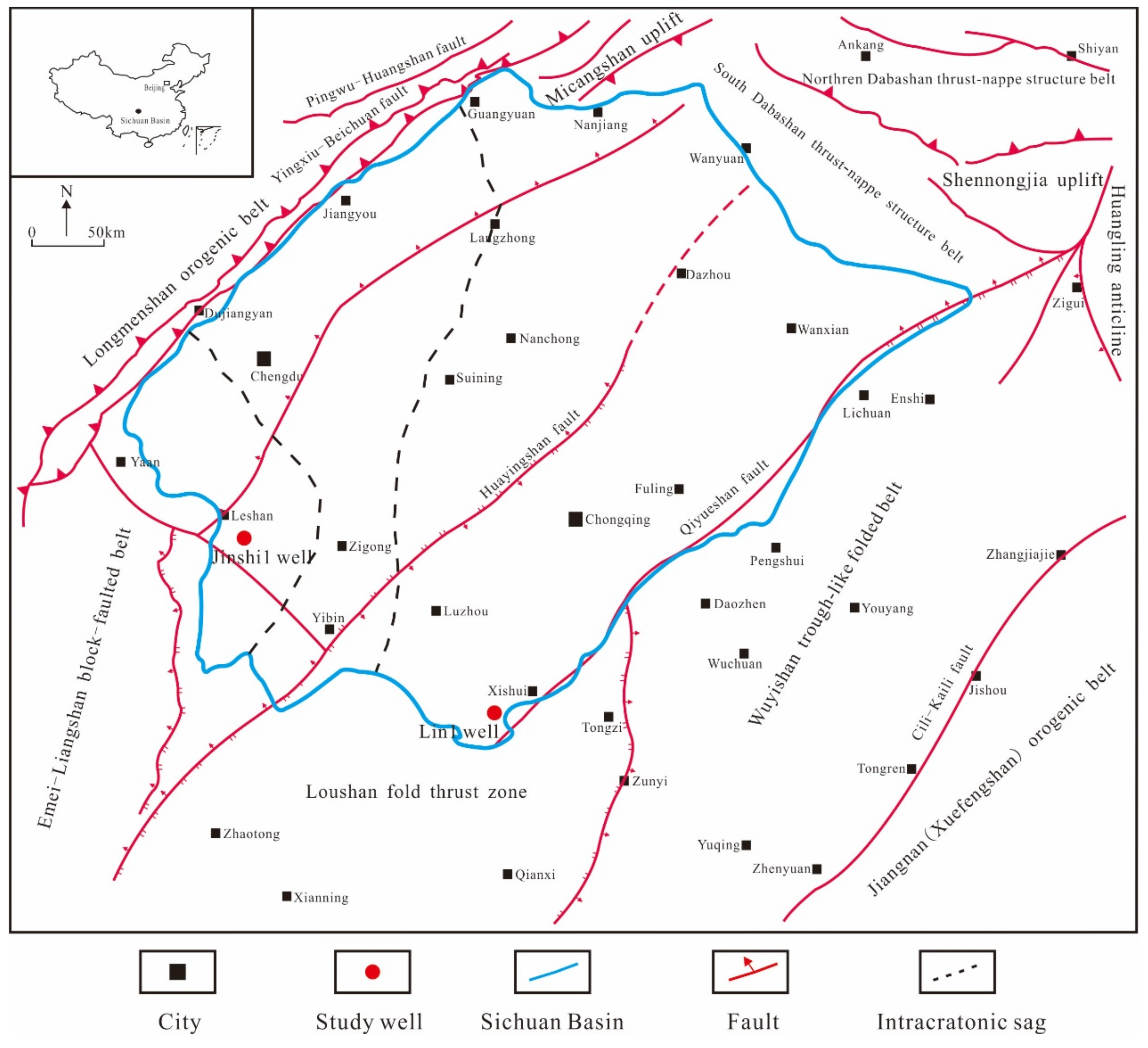

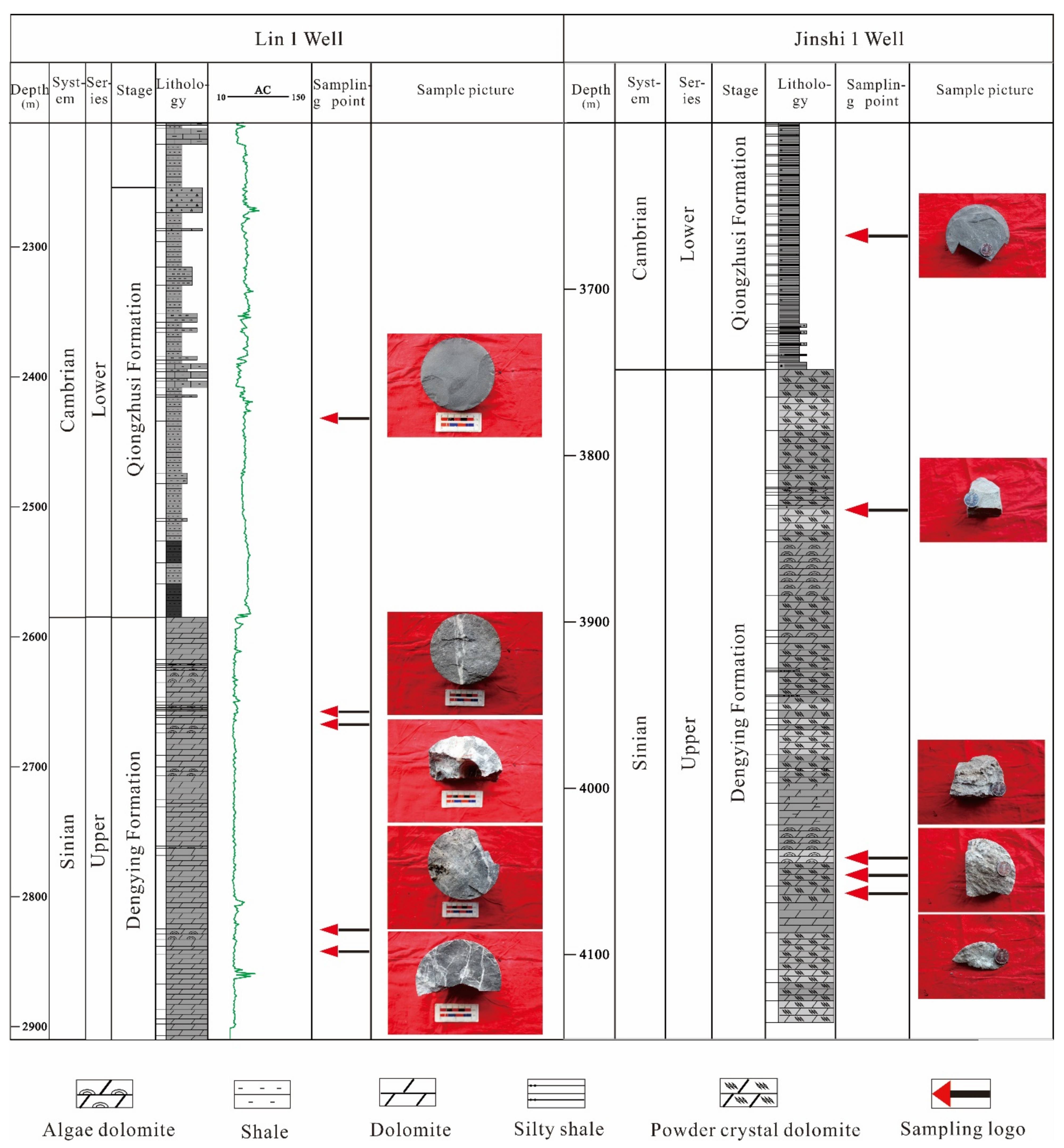
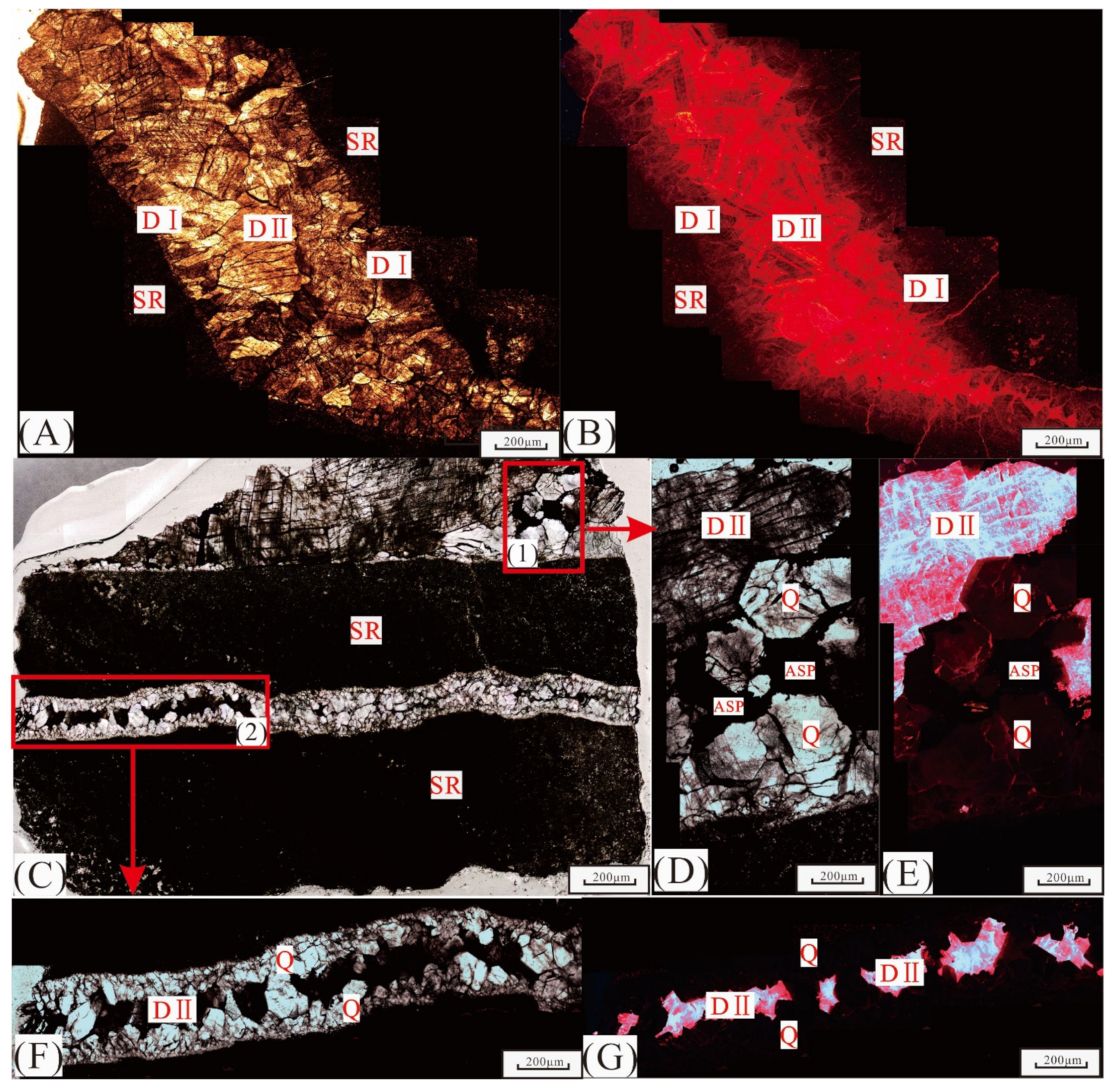
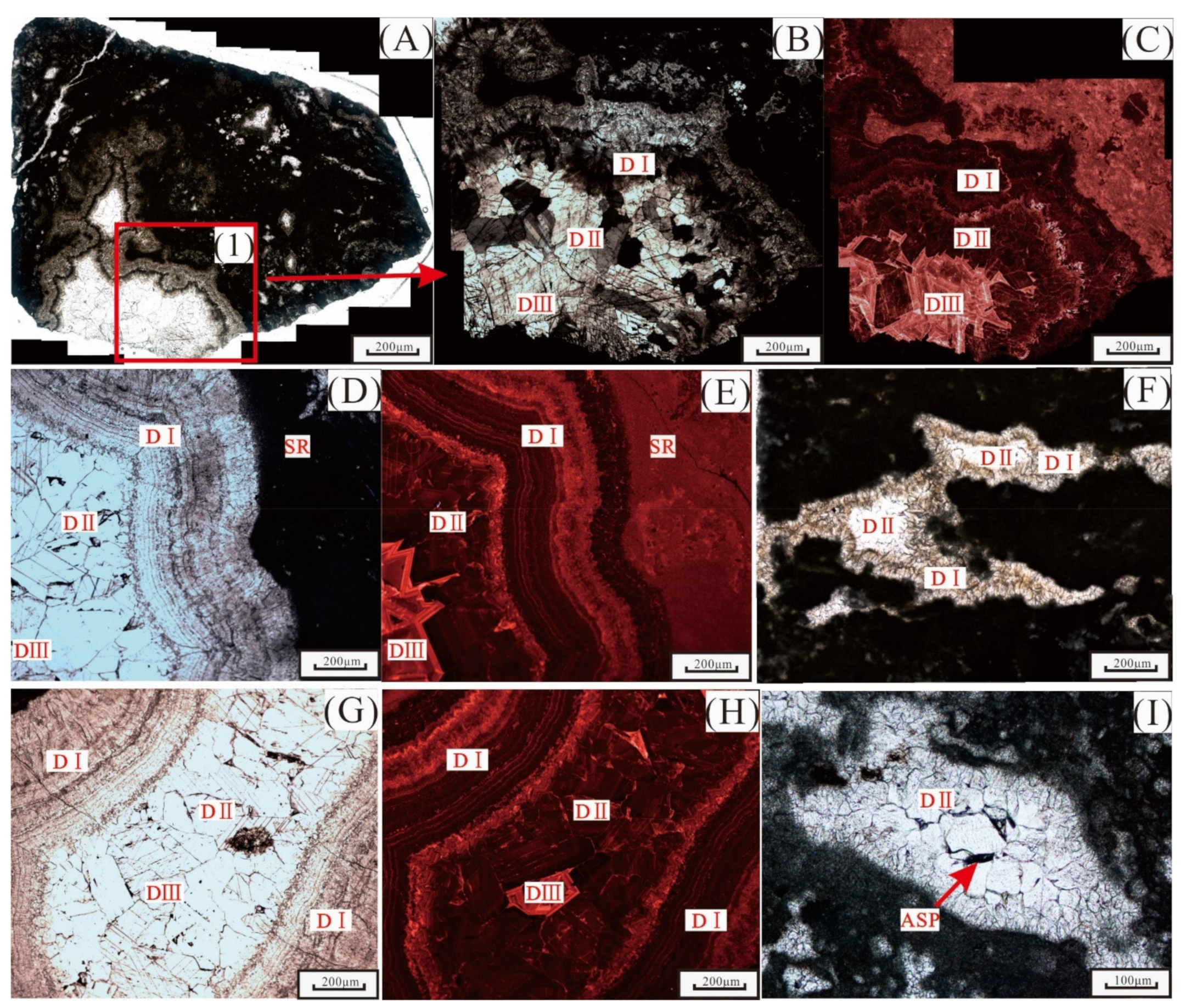

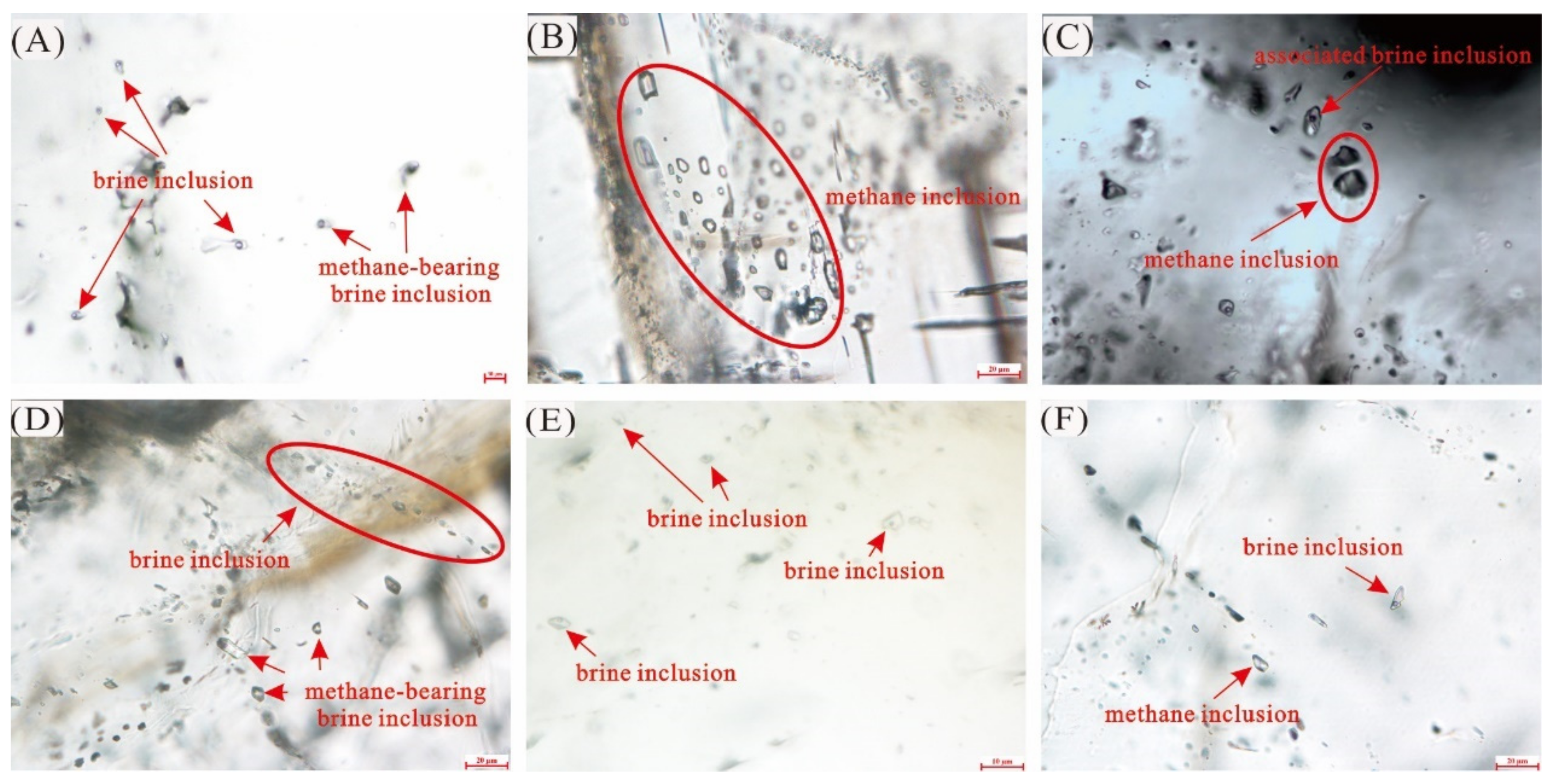

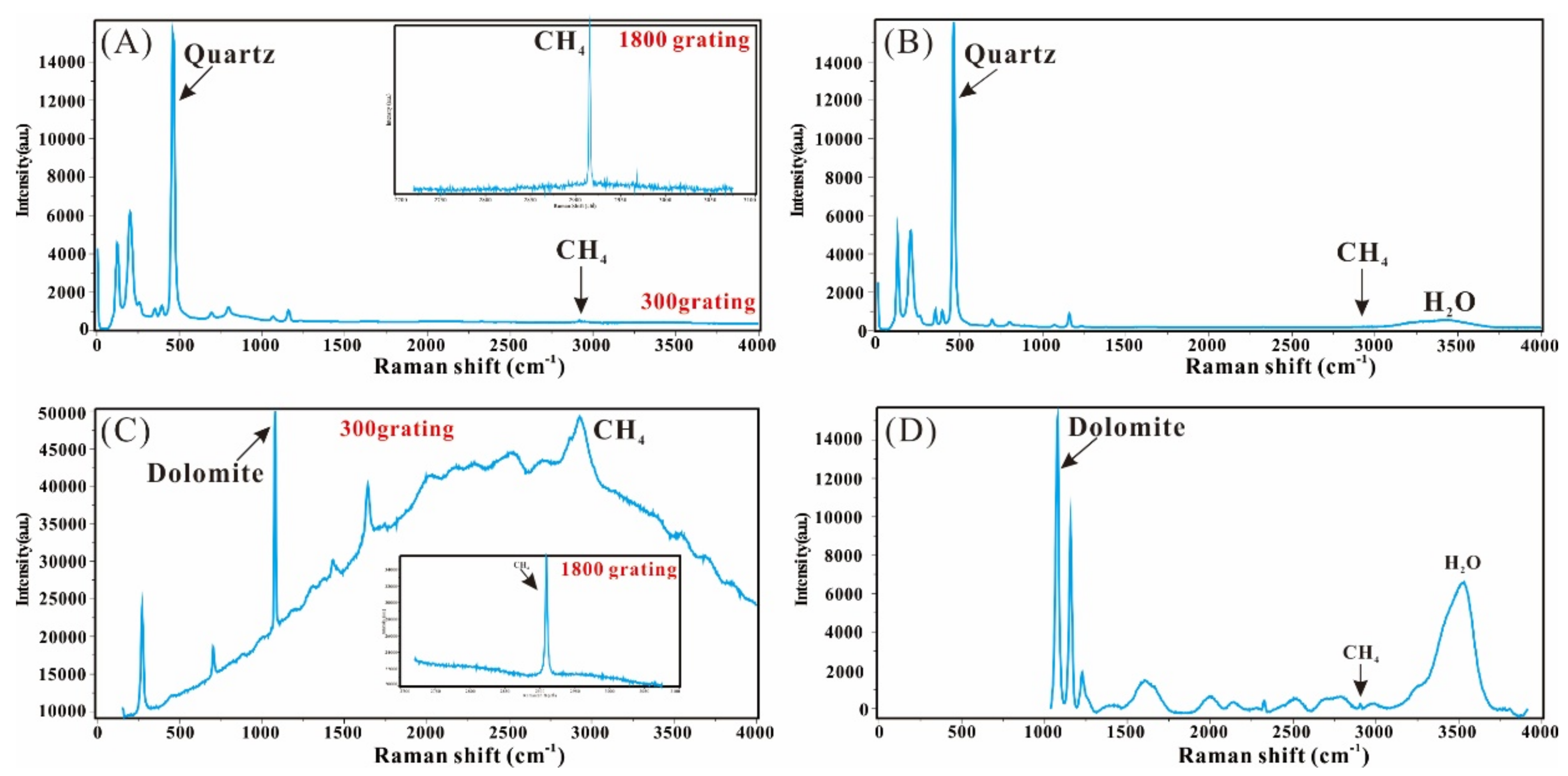
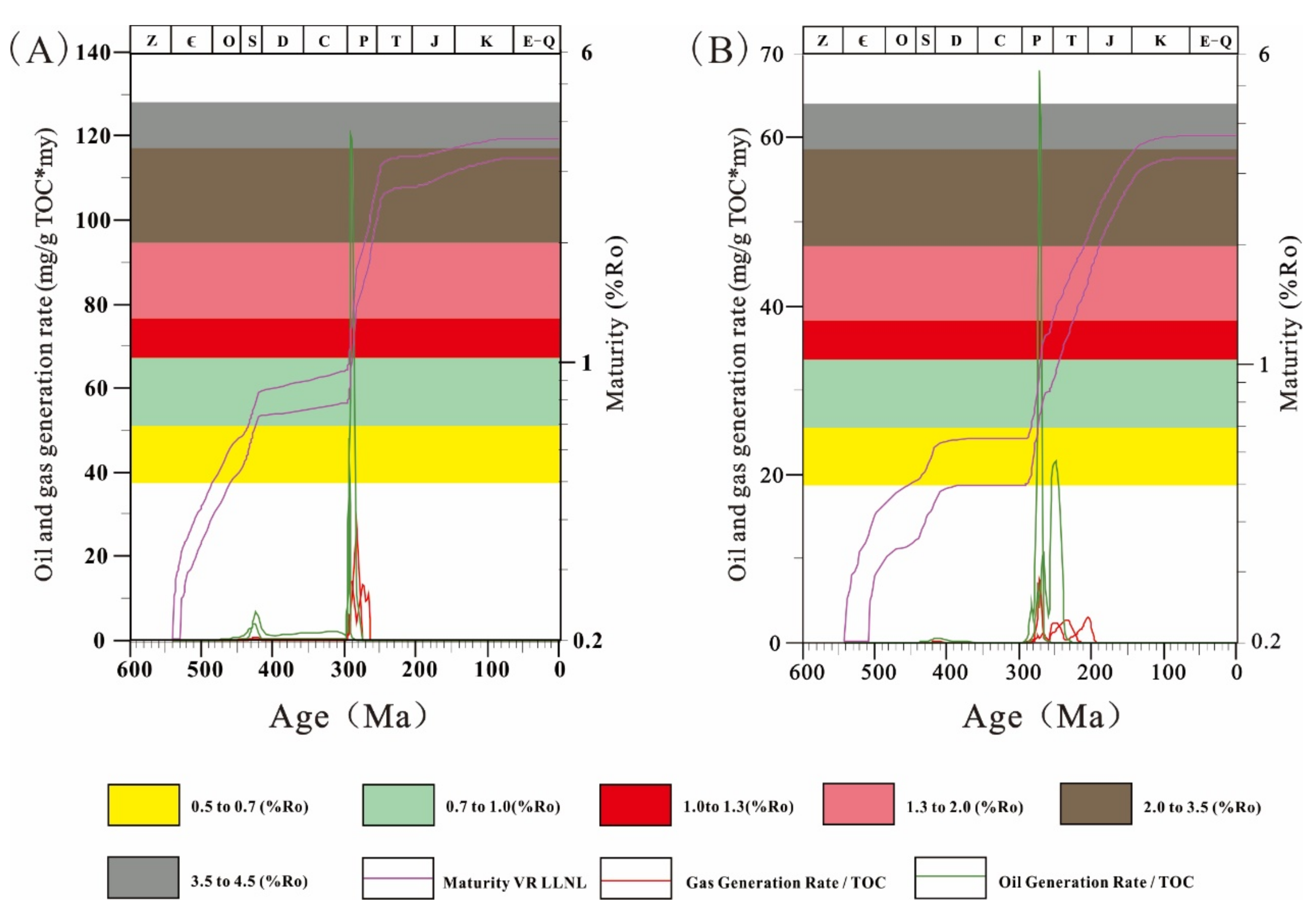
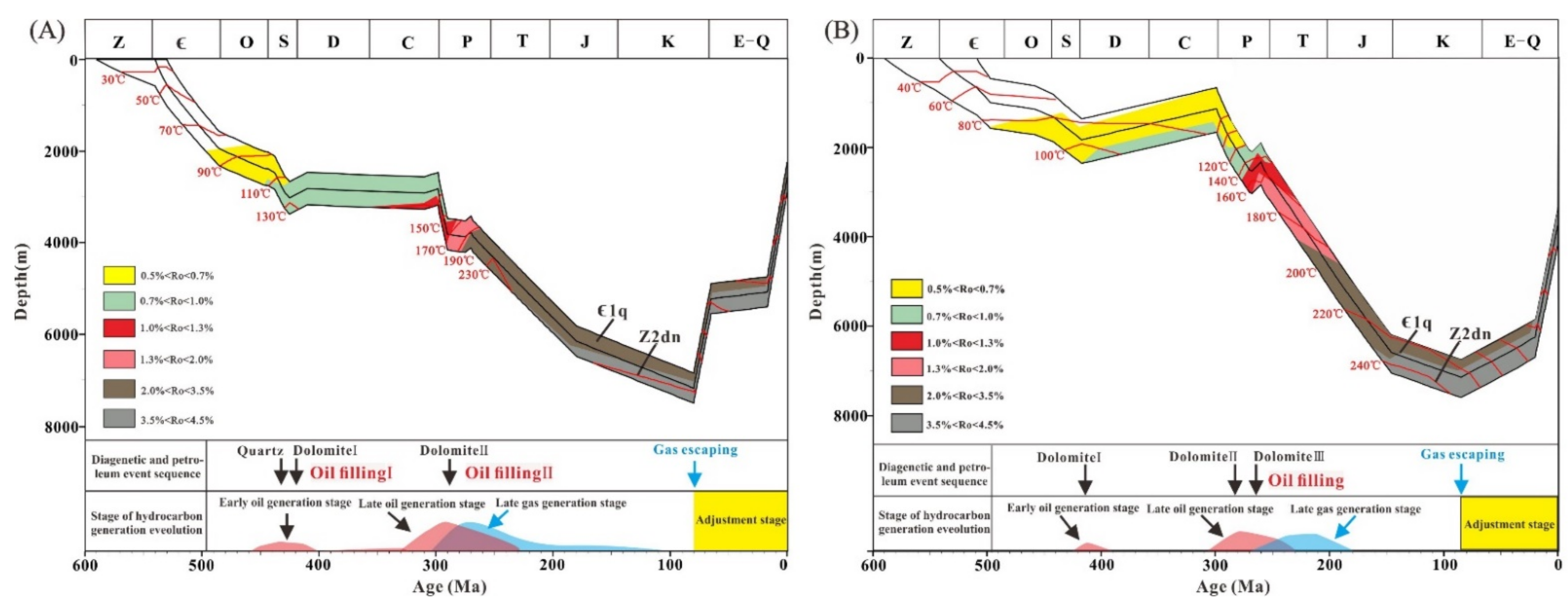
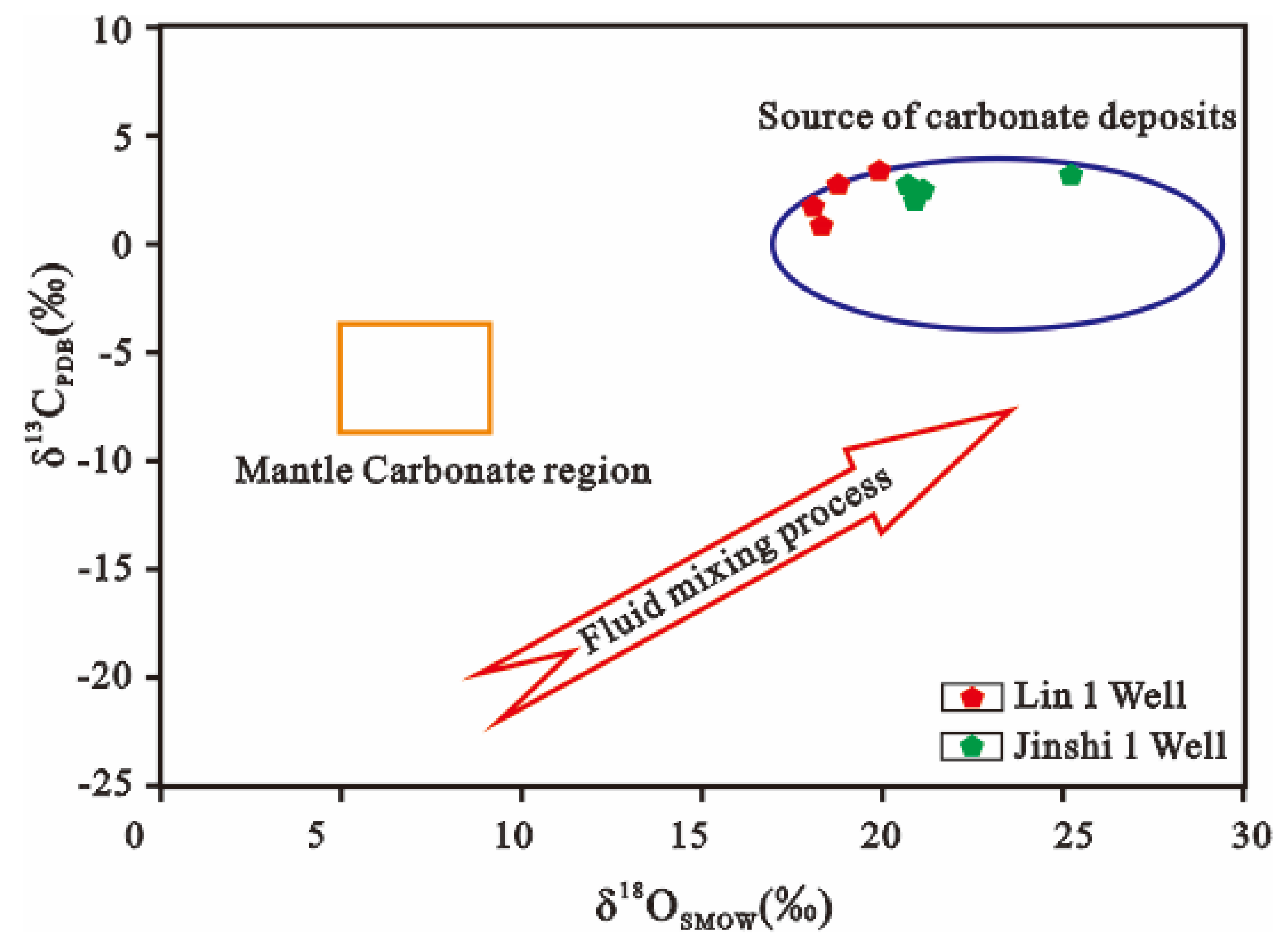
| Sample | Well | Rare Earth Element (ppm) | ∑REE (ppm) | LREE/HREE | δEu | δCe | Y/Ho | |||||||||||||
|---|---|---|---|---|---|---|---|---|---|---|---|---|---|---|---|---|---|---|---|---|
| La | Ce | Pr | Nd | Sm | Eu | Gd | Tb | Dy | Ho | Er | Tm | Yb | Lu | |||||||
| JS-4-01 | Jinshi 1 | 0.003 | 0.002 | 0.002 | 0.002 | 0.001 | 0.001 | 0.002 | 0.002 | 0.001 | 0.002 | 0.001 | 0.001 | 0.000 | 0.000 | 0.022 | 1.328 | 0.894 | 0.564 | 40.625 |
| JS-4-02 | Jinshi 1 | 0.013 | 0.010 | 0.016 | 0.018 | 0.013 | 0.024 | 0.020 | 0.016 | 0.012 | 0.014 | 0.009 | 0.009 | 0.006 | 0.008 | 0.187 | 0.990 | 1.495 | 0.665 | 49.180 |
| JS-4-03 | Jinshi 1 | 0.058 | 0.037 | 0.073 | 0.084 | 0.075 | 0.121 | 0.086 | 0.062 | 0.057 | 0.050 | 0.042 | 0.035 | 0.022 | 0.021 | 0.825 | 1.192 | 1.507 | 0.562 | 53.599 |
| JS-4-05 | Jinshi 1 | 0.012 | 0.009 | 0.022 | 0.026 | 0.029 | 0.046 | 0.030 | 0.022 | 0.021 | 0.021 | 0.015 | 0.016 | 0.009 | 0.009 | 0.286 | 1.019 | 1.552 | 0.552 | 48.186 |
| JS-4-06 | Jinshi 1 | 0.014 | 0.006 | 0.010 | 0.010 | 0.009 | 0.009 | 0.010 | 0.010 | 0.010 | 0.008 | 0.006 | 0.005 | 0.003 | 0.006 | 0.116 | 0.965 | 0.909 | 0.534 | 52.276 |
| JS-5-01 | Jinshi 1 | 0.009 | 0.003 | 0.004 | 0.005 | 0.005 | 0.006 | 0.006 | 0.004 | 0.003 | 0.003 | 0.006 | 0.002 | 0.002 | 0.003 | 0.062 | 1.092 | 1.114 | 0.518 | 65.148 |
| JS-5-02 | Jinshi 1 | 0.006 | 0.002 | 0.004 | 0.004 | 0.003 | 0.005 | 0.003 | 0.003 | 0.002 | 0.002 | 0.002 | 0.003 | 0.002 | 0.003 | 0.043 | 1.352 | 1.643 | 0.482 | 79.693 |
| JS-8-02 | Jinshi 1 | 0.033 | 0.035 | 0.054 | 0.063 | 0.071 | 0.132 | 0.079 | 0.058 | 0.048 | 0.042 | 0.031 | 0.020 | 0.015 | 0.014 | 0.696 | 1.266 | 1.753 | 0.798 | 40.185 |
| L-11-02 | Lin 1 | 0.003 | 0.003 | 0.004 | 0.005 | 0.006 | 0.006 | 0.008 | 0.008 | 0.006 | 0.008 | 0.008 | 0.006 | 0.007 | 0.004 | 0.082 | 0.492 | 0.765 | 0.747 | 32.651 |
| L-11-03 | Lin 1 | 0.004 | 0.003 | 0.005 | 0.006 | 0.008 | 0.009 | 0.009 | 0.009 | 0.011 | 0.013 | 0.008 | 0.005 | 0.008 | 0.004 | 0.102 | 0.510 | 1.156 | 0.693 | 24.537 |
| L-12-01 | Lin 1 | 0.005 | 0.002 | 0.002 | 0.002 | 0.004 | 0.006 | 0.008 | 0.004 | 0.006 | 0.005 | 0.004 | 0.002 | 0.002 | 0.004 | 0.056 | 0.568 | 1.024 | 0.457 | 51.373 |
| L-12-03 | Lin 1 | 0.007 | 0.003 | 0.005 | 0.006 | 0.009 | 0.009 | 0.007 | 0.008 | 0.010 | 0.013 | 0.011 | 0.009 | 0.006 | 0.006 | 0.110 | 0.561 | 1.100 | 0.466 | 35.785 |
| L-13-01 | Lin 1 | 0.009 | 0.007 | 0.014 | 0.020 | 0.027 | 0.049 | 0.047 | 0.042 | 0.054 | 0.052 | 0.042 | 0.042 | 0.028 | 0.020 | 0.455 | 0.388 | 1.329 | 0.607 | 35.166 |
| L-13-02 | Lin 1 | 0.010 | 0.009 | 0.019 | 0.025 | 0.028 | 0.062 | 0.048 | 0.045 | 0.054 | 0.058 | 0.048 | 0.045 | 0.038 | 0.022 | 0.512 | 0.428 | 1.628 | 0.597 | 35.610 |
| L-13-03 | Lin 1 | 0.010 | 0.007 | 0.015 | 0.017 | 0.021 | 0.039 | 0.028 | 0.030 | 0.032 | 0.034 | 0.027 | 0.022 | 0.019 | 0.010 | 0.311 | 0.538 | 1.597 | 0.595 | 33.636 |
| L-13-04 | Lin 1 | 0.012 | 0.014 | 0.030 | 0.037 | 0.046 | 0.068 | 0.067 | 0.051 | 0.058 | 0.058 | 0.042 | 0.029 | 0.026 | 0.021 | 0.558 | 0.590 | 1.218 | 0.667 | 34.526 |
| PAAS | 38.2 | 79.6 | 8.83 | 33.09 | 5.55 | 1.08 | 4.66 | 0.774 | 4.68 | 0.991 | 2.85 | 0.405 | 2.82 | 0.433 | ||||||
| Sample | Well | Type | Depth | δ13CPDB | δ18OPDB | 87Sr/86Sr | δ18OSMOW |
|---|---|---|---|---|---|---|---|
| L-1 | Lin 1 | Dolomite I | 2654.30 | 0.42 | −12.35 | 0.714824 | 18.18 |
| L-2 | Lin 1 | Dolomite I | 2826.29 | 2.13 | −12.81 | 0.711359 | 17.70 |
| L-3 | Lin 1 | Dolomite I | 2831.41 | 2.46 | −11.75 | 0.711389 | 18.80 |
| Lin1-W | Lin 1 | Surrounding rock | 2831.41 | 3.06 | −10.21 | 0.709935 | 20.38 |
| JS-1 | Jinshi 1 | Dolomite III | 4028.74 | 2.77 | −9.63 | 0.709030 | 20.98 |
| JS-2 | Jinshi 1 | Dolomite III | 4029.21 | 2.82 | −10.34 | 0.709317 | 20.24 |
| JS-3 | Jinshi 1 | Dolomite I | 4032.50 | 2.66 | −10.09 | 0.710144 | 20.51 |
| Jinshi1-W | Jinshi 1 | Surrounding rock | 4032.50 | 3.70 | −5.56 | 0.709724 | 25.17 |
Publisher’s Note: MDPI stays neutral with regard to jurisdictional claims in published maps and institutional affiliations. |
© 2022 by the authors. Licensee MDPI, Basel, Switzerland. This article is an open access article distributed under the terms and conditions of the Creative Commons Attribution (CC BY) license (https://creativecommons.org/licenses/by/4.0/).
Share and Cite
Luo, J.; Wang, F.; He, S.; He, Z.; Huang, Y.; Zhang, D.; Zhu, Y.; Sun, Z.; Luo, T. Characteristics of Vein-Forming Fluids in the Sinian Dengying Formation Reservoir and Its Relationship with the Hydrocarbon Accumulation Process in the Southwest and Southeast of the Sichuan Basin. Minerals 2022, 12, 443. https://doi.org/10.3390/min12040443
Luo J, Wang F, He S, He Z, Huang Y, Zhang D, Zhu Y, Sun Z, Luo T. Characteristics of Vein-Forming Fluids in the Sinian Dengying Formation Reservoir and Its Relationship with the Hydrocarbon Accumulation Process in the Southwest and Southeast of the Sichuan Basin. Minerals. 2022; 12(4):443. https://doi.org/10.3390/min12040443
Chicago/Turabian StyleLuo, Jing, Furong Wang, Sheng He, Zhiliang He, Yahao Huang, Dianwei Zhang, Yanxian Zhu, Ziming Sun, and Tao Luo. 2022. "Characteristics of Vein-Forming Fluids in the Sinian Dengying Formation Reservoir and Its Relationship with the Hydrocarbon Accumulation Process in the Southwest and Southeast of the Sichuan Basin" Minerals 12, no. 4: 443. https://doi.org/10.3390/min12040443
APA StyleLuo, J., Wang, F., He, S., He, Z., Huang, Y., Zhang, D., Zhu, Y., Sun, Z., & Luo, T. (2022). Characteristics of Vein-Forming Fluids in the Sinian Dengying Formation Reservoir and Its Relationship with the Hydrocarbon Accumulation Process in the Southwest and Southeast of the Sichuan Basin. Minerals, 12(4), 443. https://doi.org/10.3390/min12040443






